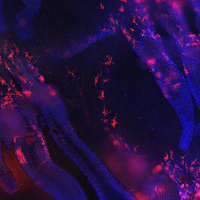Login
Subscribebacteria, cell & molecular biology

Our Favorite Cell and Molecular Biology Stories of 2021
Jef Akst | Dec 2, 2021 | 3 min read
Beyond The Scientist’s coverage of COVID-19’s molecular underpinnings were many other stories highlighting the advances made in scientists’ understanding of the biology of cells.

Stress-Induced Molecular Globs Boost Bacterial Fitness
Ruth Williams | Oct 21, 2021 | 4 min read
Liquid conglomerations of molecules that form in bacterial cells in response to stress promote the cells’ survival, a study finds.

Investigating the Immune Response Using Advanced Flow Cytometry
The Scientist | 1 min read
Discover how researchers are using flow cytometry to delve into the inner workings of the immune life cycle!

The Role of Mom’s Microbes During Pregnancy
Carolyn A. Thomson and Kathy D. McCoy | Aug 1, 2021 | 10+ min read
Bacteria in the gut influence the production of antibodies and themselves secrete metabolites. In a pregnant woman, these compounds may influence immune development of her fetus.

Human Protein Dissolves Bacterial Membranes
Abby Olena, PhD | Jul 15, 2021 | 4 min read
The protein, apolipoprotein L3, destroys invading microbes by acting as a detergent in the cytosol.

What’s the Deal with Bacterial Nanotubes?
Sruthi S. Balakrishnan | Jun 1, 2021 | 10+ min read
Several labs have reported the formation of bacterial nanotubes under different, often contrasting conditions. What are these structures and why are they so hard to reproduce?

New Bacterium Linked to Chimp Deaths
Asher Jones | Feb 3, 2021 | 2 min read
The newly discovered microbe seems to be responsible for a mysterious neurological disease that has killed dozens of critically endangered Western chimpanzees.

Retrons Help Bacteria Defend Themselves from Phages: Study
Catherine Offord | Feb 1, 2021 | 2 min read
The mysterious DNA sequences appear to help bacterial cells spot when they’ve been infected with viruses—and prompt those cells to self-destruct.

Lipid Droplets Are Intracellular Bacteria-Fighting Machines
Ruth Williams | Oct 15, 2020 | 3 min read
Far from being inert fat-storage depots within cells, these lipid-loaded organelles recruit immune proteins and block bacterial growth.

Image of the Day: Inflamed Mouse Follicles
Emily Makowski | Dec 16, 2019 | 2 min read
Normal hair growth can lead to infection during cancer treatment.

How Worms Avoid Eating Bad Bacteria and Warn Their Offspring Too
Jef Akst | Dec 12, 2019 | 3 min read
A small RNA in Pseudomonas triggers an avoidance response in C. elegans that can be passed on to the next generation, according to research presented at this week’s meeting of the American Society for Cell Biology.

Lab-Evolved E. coli Consume Carbon Dioxide
Emily Makowski | Nov 27, 2019 | 3 min read
Bacteria that take in inorganic carbon could have applications in sustainable biofuels.

Elusive Asgard Archaea Finally Cultured in Lab
Nicoletta Lanese | Aug 12, 2019 | 3 min read
The 12-year-long endeavor reveals Prometheoarchaeum as a tentacled cell, living in a symbiotic relationship with methane-producing microbes.

Bacteria Harbor Geometric “Organelles”
Amber Dance | Dec 1, 2018 | 10+ min read
Microbes, traditionally thought to lack organelles, get a metabolic boost from geometric compartments that act as cauldrons for chemical reactions. Bioengineers are eager to harness the compartments for their own purposes.

Infographic: Bacterial Microcompartments Basics
Amber Dance | Dec 1, 2018 | 1 min read
These icosahedral structures are composed of proteins with unique geometric properties, which enable bacteria to employ them in a variety of situations.

The Cell’s Integrated Circuit: A Profile of Lucy Shapiro
Anna Azvolinsky | Aug 1, 2018 | 9 min read
Shapiro helped to found the field of systems biology.

Stanley Falkow, Father of Molecular Microbial Pathogenesis, Dies
Catherine Offord | May 9, 2018 | 3 min read
The microbiologist was known for his work on bacterial antibiotic resistance and infectious disease.

Researchers Discover 10 New Immune Systems in Bacteria
Jim Daley | Jan 25, 2018 | 3 min read
The findings more than double the number of known defense mechanisms, piquing the interests of molecular biology tool developers.

Artificial Cells Talk to Real Ones
Jef Akst | Jan 31, 2017 | 1 min read
Nonliving cells developed in the lab can communicate chemically with living bacteria, according to a study.
